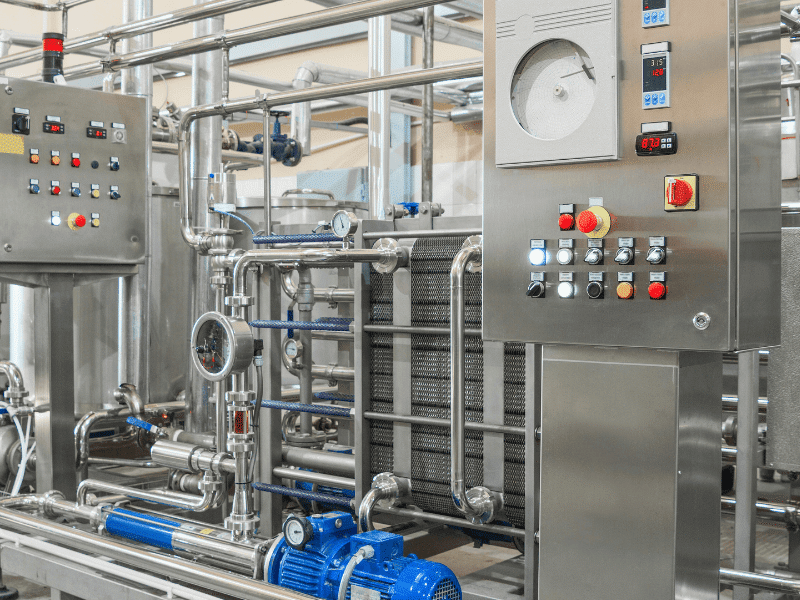High-strength epoxy is super useful for tough fixes. When things break in big ways, like in factories or on machines, you need something really strong. That’s where high-strength epoxy comes in. It’s made to bond things together really well and last a long time, even when things get rough. 1 This blog will tell you why it’s the best choice for heavy-duty repairs that need to hold up.
Understanding High-Strength Epoxy
High-strength epoxy is significantly strong glue that’s used for big, tough repairs. We shall read what it’s made of and what makes it special.
Definition and What’s Inside
Think of epoxy as two parts that need to be mixed together to work.
Two-Part System
Epoxy comes in two bottles. One bottle has the resin, and the other has the hardener. The resin is often made from something called bisphenol-A (BPA) for strong, all-around use. If you need extra protection from harsh chemicals, some epoxies use bisphenol-F (BPF) resin.
Hardeners:
The hardener makes the resin solid and strong. Different hardeners give epoxy different traits. Polyamines make epoxy really tough, so it can take a beating. Polyamides make epoxy bendier and help it stick better to surfaces that might move a little.
Polymerization
When you mix the resin and hardener, something cool happens. It’s called polymerization. This is a chemical reaction where tiny parts link together to make a giant, strong network. It even creates heat! This process makes the epoxy change from liquid to a super-strong solid.
Additives
Sometimes, makers add extra things to epoxy to make it even better for certain jobs. These are called additives.
Fillers: Things like silica or calcium carbonate can be added. These are like tiny powders that make the epoxy thicker, cheaper, and change how it flows.
Accelerators: If you need the epoxy to dry faster, they add accelerators. These speed up the hardening process.
Flexibilizers: To make epoxy less stiff and more able to bend without breaking, they add flexibilizers. These are good when the parts you’re fixing might move or shake.
Key Features of High-Strength Epoxy
What makes high-strength epoxy stand out? It’s all about its amazing features:
Molecular Adhesion:
Epoxy doesn’t just stick on top of things. It actually grabs onto surfaces at a very tiny level, using forces called van der Waals forces and chemical bonds. This is how it can stick to all sorts of things, even smooth stuff like glass and rough stuff like wood or concrete. It works on porous materials and non-porous materials alike!
Stronger than Other Glues
Epoxy is way stronger than many other glues used in factories. For example, polyurethane adhesives are bendy but not as strong. Cyanoacrylate adhesives dry fast but can be weak and break easily if bent or pulled apart. Epoxy can have an adhesion strength of 10,000 PSI or even more!
Critical Strength Applications
Structural bonding in construction, making airplanes safe (aerospace component assemblies like aircraft wings and fuselages), and building tough cars (high-performance automotive parts).
Lasts a Long Time
Compressive Strength and Mechanical Stress Resistance. Epoxy is super strong when squeezed (high compressive strength, over 15,000 PSI!). It’s also tough when pulled or twisted (tensile and shear stresses). This means it can handle a lot of force without breaking down.
Toughness Against Vibrations and Shock. In factories and machines, things shake and bump a lot. Epoxy is tough enough to handle these vibrations and shock loads without cracking or losing its grip. This is important in industrial settings.
Real-World Toughness. Look at bridge decks. They have cars and trucks driving over them all day, plus weather changes. Epoxy repairs on bridges can last for years, even with all that stress. Pipelines buried underground are often coated with epoxy to protect them from damage and keep them working for decades.
Benefits of High-Strength Epoxy in Heavy-Duty Repairs
Protection Against Environmental Factors
Epoxy coatings are like a shield. They protect against abrasion (scratches and scrapes from heavy use), impact (hits from tools and machines), and UV exposure (sun damage that can weaken materials). This protection helps things last much longer. If you use epoxy on something outside, it won’t get worn down as fast by the sun, rain, and wind.
Makes Weak Things Strong Again
Sometimes things get cracked and weak. Epoxy can help fix that. If concrete cracks, epoxy can fill in the cracks and glue them back together. If metal parts start to rust, epoxy can cover the rust and create a strong layer to support the weak metal.
Stronger Molecular Bonds vs. Mechanical Fasteners
Normally, we use screws, bolts, or rivets to hold things together (mechanical fasteners). But epoxy actually sticks parts together at a tiny molecular level. This creates a continuous and strong bond over the whole surface, not just in a few spots like screws.
This spread-out strength (distributed stress transfer) makes epoxy joints really strong and less likely to break, especially when things are shaking or moving. This is super important for things made of composite materials, which are used in high-tech stuff.
Case Studies in High-Stress Environments
Wind Turbine Blades
Those giant blades on wind turbines face crazy winds and vibrations. Over time, they can get cracks or the edges can wear down (leading-edge erosion). Epoxy is used to repair these blades so they can keep spinning and making clean energy, even in harsh weather.
Machine Fixes:
In factories, machines have parts that wear out, like shafts, gears, and bearing housings. Instead of throwing away the whole machine, epoxy can be used to rebuild these worn parts. This gets the machine working again (machine part restoration) and keeps factories running without huge costs
Cheaper Than Replacing
When big machines or building parts break, you have two choices: repair or replace. Replacing things like big machines or whole sections of buildings is super expensive. You have to pay for new parts (new part procurement), take out the old stuff, put in the new installation, and deal with things being shut down while you do the work (downtime). Epoxy repair is usually much cheaper than all that (material + labor).
Applications of High-Strength Epoxy for Heavy-Duty Repairs
Epoxy is for very strong fixes. It’s used for jobs needing strength. Many tough jobs use it. It’s known to be reliable.
Construction
In construction, epoxy is key. For bolts and rods, epoxy is used. It holds them tight in concrete and brick. This makes buildings safe. Safety barriers stay put. It’s hard to pull these bolts out.
Concrete sometimes cracks. Crack repairs use epoxy. Epoxy fills the cracks deep down. This stops water leaks. Buildings become strong again. Special ways push epoxy into deep cracks.
Water leaks are bad. For sealing and waterproofing, use epoxy. It makes layers that water can’t pass. Good for basements and tunnels. Also, for bridge decks. Epoxy blocks water. It even stops chemicals from groundwater.
Automotive
Cars use epoxy too. For automotive fixes, it’s great. Automotive repairs include dents and rust. Epoxy fixes them. New cars use special parts. These are composite parts. Epoxy glues them well. It also strengthens car frames. Cars become safer in crashes.
Boats need to be waterproof. For marine uses, epoxy is important. Marine repairs use epoxy for boat holes. For boat hull repair, it’s great. Epoxy makes boats strong. It stops water from getting in. Coatings of epoxy stop sea stuff from sticking to boats.
Manufacturing
Factories need machines working. In manufacturing, epoxy helps. Machinery repair uses epoxy for worn parts. Gears and shafts can be fixed. Machines last longer. Factories save time when machines work.
Factory floors must be strong. Floor coatings of epoxy are tough. These floors work in factories and garages. They stop chemicals from damage. They stop scratches. They stop heat. Epoxy floors are very strong. Some are not slippery. Some stop static electricity.
DIY and Home Repairs
At home, epoxy is also useful. For DIY and home repairs, it’s handy. Structural fixes at home use epoxy. Wood beams can be fixed. Stairs can be repaired. Fences last longer with epoxy. Homes become safer.
Leaks in pipes are common. For plumbing applications, epoxy works. Plumbing applications use epoxy to seal pipes. It fixes metal and plastic pipes. Cracked toilets can be fixed. Bathrooms can be made waterproof. No more water damage.
Best Ways to Use High-Strength Epoxy
Follow these steps for best epoxy use. Good steps mean strong repairs. Take time to do it right.
Surface Preparation
First, surface preparation is key. Make surfaces a bit rough. For mechanical abrasion, use sandpaper. Or use grinders. Or media blasting. Rough surfaces help epoxy stick. Bonds become stronger.
For concrete, use acid etching. Acid etching for concrete uses acid to clean it. Muriatic acid works. Acid removes a weak top layer. It opens tiny holes in concrete. Epoxy then sticks better to concrete. Wash off acid after using. Let concrete get fully dry.
Mixing and Application
Next is mixing and application. Measuring ratios must be right. Mix resin and hardener correctly. Follow instructions for amounts. Measure by weight or volume. Wrong amounts are bad. The epoxy may not harden. It could be weak. Or it might be sticky.
Use good mixing tools. For tubes of epoxy, use static mixers. They mix epoxy as you use it. Mixing is always even. Dual-cartridge systems are easy to use. They give right amounts. For hand mixing, use clean sticks. Use clean cups. Stir well. Mix until color is even. Mix until it’s all same thickness.
For application techniques, use right tools. For big areas, use brushes. For cracks, use syringes. For filling holes, use spatulas. For big jobs, use injection guns. Injection guns push epoxy in hard.
Do not Forget Safety Precautions
Always think about safety precautions. Safety is important with epoxy. Good ventilation is needed. Epoxy fumes are not good. Breathing fumes can be bad. Work in the open air. Use fans to blow fumes away.
Wear PPE. PPE means safety gear. Wear nitrile gloves. Latex gloves are not good for epoxy. Wear safety goggles. Or wear face shields. Protect your eyes. Use a respirator if needed. For long work, use a respirator. Wear long sleeves too. And aprons. Protect your skin.
For disposal guidelines, be careful. Throw away epoxy safely. Let mixed epoxy get hard first. Then throw it out. Throw it in trash. Don’t pour liquid epoxy down drains. Check local rules for chemicals. Some places have special spots for chemical waste.
Summary
Epoxy is great for tough fixes. It is very strong. It lasts long. It works in hard places. Use it for big and small repairs. Use it the right way. And be safe when using it.
Jiuju Tech gives you premium quality, high-strength industrial adhesives. You can place order for epoxy at competitive rates. These products are designed for tough jobs in industries like automotive, electronics and construction.
FAQs
Is high-strength epoxy really tough?
Yes! It’s made to be super strong for repairs that need to last. It is like the strongest glue you can get for big jobs in factories, boats, and buildings.
Can I use this epoxy on metal stuff outside?
Yes, you sure can. Lots of high-strength epoxies are made just for metal. And if you’re fixing things outdoors, get the kind that can handle sun, rain, and cold.
What’s “two-part” epoxy mean?
If it says “two-part,” it just means you get two things in the pack. You have to mix them together to make the glue work. Mix them well!
How fast does this strong glue dry?
It dries at different speeds. Some types dry super fast, like in a few minutes – good for quick fixes. Others take longer, maybe hours or even a whole day, to get really hard. For the strongest fixes, you usually have to wait longer. Always look at the package to see how long that kind takes to dry.





